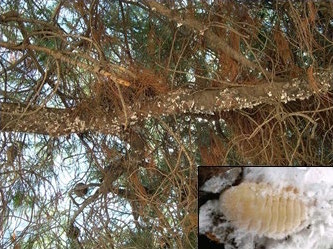PESTS AND DISEASES OF FORESTRY IN NEW ZEALAND
Giant pine scale in Australia
Scion is the leading provider of forest-related knowledge in New Zealand
Formerly known as the Forest Research Institute, Scion has been a leader in research relating to forest health for over 50 years. The Rotorua-based Crown Research Institute continues to provide science that will protect all forests from damage caused by insect pests, pathogens and weeds. The information presented below arises from these research activities.
From Forest Health News 254, March 2015.
Established populations of the giant pine scale (Marchalina hellenica), a Mediterranean sap-sucking insect, have been recently discovered on pines in Australia. It has been found in two separate locations: Melbourne (Victoria) and Adelaide (South Australia); and to date has only been recorded from three hosts: Pinus halepensis, P. pinea and P. radiata.
Giant pine scale is native to pine forests of the eastern Mediterranean region where it is found mainly on Pinus brutia and P. halepensis, and occasionally on other Pinus, Abies and Picea species. Large populations of the scale can cause severe dehydration, defoliation and branch dieback of host trees, and in some cases, tree death. Despite its pest status, the scale is highly valued in Greece and in Turkey for its role in the production of honeydew honey (“pine honey”); at one time up to 65% of all Greek honey was estimated to have been derived from giant pine scale honeydew. Indeed, between 1996 and 2000, Greek beekeepers were encouraged to artificially introduce the scale in pine forests to increase their honey production!
Although it is too early to know the potential impact of giant pine scale in Australia, the case was considered sufficiently serious to initiate an eradication programme targeting the affected areas.
Giant pine scale develops in bark crevices and favours the lower parts of the host tree. It is usually found on the trunk, but may also occur on branches and exposed tree roots. As they feed, scale nymphs produce a conspicuous white wax secretion that protrudes from the surface of the tree (see photo below), as well as large amounts of honeydew, which can support the growth of sooty mould. There is usually one generation per year (although two generations in one year has been recorded). Mature females each produce 200-300 eggs, which are laid in batches in bark crevices and covered with the same white wax secretion by the female. Like many scales, this species has very low natural dispersal.

Nymph of Marchalina hellenica (inset). Photo: A. Battisti.
In its native range, the giant pine scale cohabits with a relatively large scale insect community, most of them competing with each other for food sources. A recent study in Turkey also shows the scale is attacked by a variety of predators, among which one species appears more common and effective (Neoleucopis kartliana, which belongs to the Chamaemyiidae - a small group of predatory flies specialising in sap-sucking insects).
Based on its apparent reliance on humans for long distance spread, its breeding cycle of one generation per year and its conspicuous appearance the scale is not likely to get to New Zealand. If it did chances are good that it would be detected early and be able to be eradicated. Nevertheless, New Zealand readers are encouraged to be alert for the distinctive signs of this potential pine pest. We wish our Australian colleagues all the best for a successful eradication programme and thank David Smith from the Department of Economic Development, Jobs, Transport and Resources in Victoria for his assistance.
Belinda Gresham & Nicolas Meurisse (Forest Protection Scion).
This information is intended for general interest only. It is not intended to be a substitute for specific specialist advice on any matter and should not be relied on for that purpose. Scion will not be liable for any direct, indirect, incidental, special, consequential or exemplary damages, loss of profits, or any other intangible losses that result from using the information provided on this site.
(Scion is the trading name of the New Zealand Forest Research Institute Limited.)

 Farm Forestry New Zealand
Farm Forestry New Zealand

